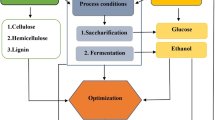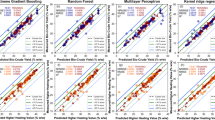Abstract
The study focuses on enhancing the efficiency of bioethanol production as a means to reduce reliance on crude oil and mitigate environmental pollution. A key aspect involves the optimization of bioethanol production through the application of an artificial intelligence approach. The Artificial Intelligence Decision-Making System (AIDMS) algorithm was developed using a machine learning algorithm, utilizing datasets derived from experimental results and published research. In the optimization process, a Pearson correlation coefficient matrix was established for 250 training datasets, revealing positive and negative correlation coefficient values. These values underscore the significance of each parameter in ethanol production. Various biomass feedstocks, including cotton stalk, wheat straw, olive tree, potato peel waste, rice straw, and sugarcane bagasse, were selected for validation of the AIDMS algorithm. The validation process compared experimental results with predictions made by the AIDMS, demonstrating a commendable 94% accuracy. The weighted rank order aggregate analysis revealed that cellulose (%), s-temp (°C), acid conc. (%), lignin (%), s-time (min), and hemicellulose (%) show the importance of parameters in obtaining glucose yield. Similarly for ethanol yield, cellulose (%), f-temp (°C), f-time (h), lignin (%), and hemicellulose (%) show the order of rank and its importance. The artificial intelligence-based optimization method is suitable for bioethanol production.








Similar content being viewed by others
Data availability
The datasets used and/or analyzed during the current study are available from the corresponding author on reasonable request.
References
Duarte GT, De Alencar Nääs I, Da Silva Lima ND (2021) Estimating the urban environmental impact of gasoline-ethanol blended fuels in a passenger vehicle engine. Environmental Science and Pollution Research,, pp 1–12
Bulus GC, Koc S (2021) The effects of FDI and government expenditures on environmental pollution in Korea: the pollution haven hypothesis revisited. Environmental Science and Pollution Research 28(28):38238–38253
Mele M, Magazzino C (2021) Pollution, economic growth, and COVID-19 deaths in India: a machine learning evidence. Environ Sci Pollut Res 28:2669–2677
Demiray E, Karatay SE, Dönmez G (2019) Improvement of bioethanol production from pomegranate peels via acidic pretreatment and enzymatic hydrolysis. Environmental Science and Pollution Research 26:29366–29378
Casabar JT, Unpaprom Y, Ramaraj R (2019) Fermentation of pineapple fruit peel wastes for bioethanol production. Biomass Conversion and Biorefinery 9(4):761–765
Osman ME, Abo-Shady AM, Elshobary ME, Abd El-Ghafar MO, Abomohra AE-F (2020) Screening of seaweeds for sustainable biofuel recovery through sequential biodiesel and bioethanol production. Environmental Science and Pollution Research 27:32481–32493
Binod P, Sindhu R, Singhania RR, Vikram S, Devi L, Nagalakshmi S, Kurien N, Sukumaran RK, Pandey A (2010) Bioethanol production from rice straw: an overview. Bioresour Technol 101(13):4767–4774
Duque A, Álvarez C, Doménech P, Manzanares P, Moreno AD (2021) Advanced bioethanol production: from novel raw materials to integrated biorefineries. Processes 9(2):206
Long F, Liu H (2023) An integration of machine learning models and life cycle assessment for lignocellulosic bioethanol platforms. Energy Conv Manag 292:117379
Xu Z, Huang F (2014) Pretreatment methods for bioethanol production. Applied biochemistry and biotechnology 174(1):43–62
Sahu S, Pramanik K (2018) Evaluation and optimization of organic acid pretreatment of cotton gin waste for enzymatic hydrolysis and bioethanol production. Applied biochemistry and biotechnology 186(4):1047–1060
Demiray E, Kut A, Karatay SE, Dönmez G (2021) Usage of soluble soy protein on enzymatically hydrolysis of apple pomace for cost-efficient bioethanol production’, Fuel. Fuel 289:119785
Kumar AK, Parikh BS, Pravakar M (2016) Natural deep eutectic solvent mediated pretreatment of rice straw: bioanalytical characterization of lignin extract and enzymatic hydrolysis of pretreated biomass residue. Environmental Science and Pollution Research 23:9265–9275
Tulashie, SK, Akpari, EEA, Appiah, G, Adongo, A & Andoh, EK 2021, 'Acid hydrolysis of sawdust waste into bioethanol', Biomass Conversion and Biorefinery, pp. 1–14.
Slathia PS, Raina N, Kiran A, Kour R, Bhagat D, Sharma P (2020) Dilute acid pretreatment of pine needles of Pinus roxburghii by response surface methodology for bioethanol production by separate hydrolysis and fermentation. Biomass Conversion and Biorefinery 10(1):95–106
De Farias Silva CE, Bertucco A (2017) Dilute acid hydrolysis of microalgal biomass for bioethanol production: an accurate kinetic model of biomass solubilization, sugars hydrolysis and nitrogen/ash balance. Reaction Kinetics, Mechanisms and Catalysis 122(2):1095–1114
Dai Z, Chen Z, Selmi A, Jermsittiparsert K, Denić NM, Nеšić Z (2021) Machine learning prediction of higher heating value of biomass. Biomass Convers Biorefin, 1–9
Pereira LMS, Milan TM, Tapia-Blácido DR (2021) Using response surface methodology (RSM) to optimize 2G bioethanol production: a review. Biomass and Bioenergy 151:106166
Seo MW, Lee SH, Nam H, Lee D, Tokmurzin D, Wang S, Park Y-K (2022) Recent advances of thermochemical conversion processes for biorefinery. Bioresource technology 343:126109
Milić M, Petković B, Selmi A, Petković D, Jermsittiparsert K, Radivojević A, Milovancevic M, Khan A, Vidosavljević ST, Denić N (2021) ‘Computational evaluation of microalgae biomass conversion to biodiesel. Biomass Convers Biorefin, 1–8
Owusu WA, Marfo SA (2023) Artificial intelligence application in bioethanol production. Int J Energy Res 2023
Momenitabar M, Ebrahimi ZD, Abdollahi A, Helmi W, Bengtson K, Ghasemi P (2023) An integrated machine learning and quantitative optimization method for designing sustainable bioethanol supply chain networks. Decis Analytics J 7:100236
Zhang Y, Li R&, Zhang J (2021) Optimization scheme of wind energy prediction based on artificial intelligence. Environmental Science and Pollution Research 28:39966–39981
Smuga-Kogut M, Kogut T, Markiewicz R, & Słowik A (2021) Use of machine learning methods for predicting amount of bioethanol obtained from lignocellulosic biomass with the use of ionic liquids for pretreatment. Energies 14(1):243
Huntington T, Cui X, Mishra U, Scown CD (2020) Machine learning to predict biomass sorghum yields under future climate scenarios. Biofuels, Bioproducts and Biorefining 14(3):566–577
Kylili K, Kyriakides I, Artusi A, Hadjistassou C (2019) Identifying floating plastic marine debris using a deep learning approach. Environmental Science and Pollution Research 26:17091–17099
Palanisamy A, Soundarrajan N, Ramasamy G (2021) Analysis on production of bioethanol for hydrogen generation. Environ Sci Pollut Res 28(45):63690–63705
Petković B, Petković D, Kuzman B (2022) Adaptive neuro fuzzy predictive models of agricultural biomass standard entropy and chemical exergy based on principal component analysis. Biomass Convers Biorefin 12(7):2835–2845
Gundupalli MP, Cheng Y-S, Chuetor S, Bhattacharyya D, & Sriariyanun M (2021) Effect of dewaxing on saccharification and ethanol production from different lignocellulosic biomass. Bioresource technology 339:125596
Sundarrajan P, Gopinath KP, Arun J, Gracepavithra K, Pavendan K, Adithyajoseph A (2020) An insight into carbon balance of product streams from hydrothermal liquefaction of Scenedesmus abundans biomass. Renewable Energy 151:79–87
Świątek K, Gaag S, Klier A, Kruse A, Sauer J, Steinbach D (2020) Acid hydrolysis of lignocellulosic biomass: Sugars and furfurals formation. Catalysts 10(4):437
Sriariyanun M, Amnuaycheewa P, Rodiahwati W, Sanvarinda PP, Cheenkachorn K, & Tawai A (2017) Effect of organic acid pretreatment on Napier grass (Pennisetum purpureum) straw biomass conversion. 10:2Applied Science and Engineering Progress
Miller GL (1959) Use of dinitrosalicylic acid reagent for determination of reducing sugar. Anal Chem 31(3):426–428
Caputi A, Ueda M, Brown T (1968) Spectrophotometric determination of ethanol in wine. Am J Enol Viticult 19(3):160–165
Bansal M, Goyal A, Choudhary A (2022) A comparative analysis of K-nearest neighbor, genetic, support vector machine, decision tree, and long short term memory algorithms in machine learning. Decis Analytics J 3:100071
Victoria AH, Maragatham G (2021) Automatic tuning of hyperparameters using Bayesian optimization. Evolving Systems 12(1):217–223
Cho H, Kim Y, Lee E, Choi D, Lee Y, Rhee W (2020) Basic enhancement strategies when using Bayesian optimization for hyperparameter tuning of deep neural networks. IEEE access 8:52588–52608
Wu J, Chen X-Y, Zhang H, Xiong L-D, Lei H, Deng S-H (2019) Hyperparameter optimization for machine learning models based on bayesian optimization. J Electron Sci Technol 17(1):26–40
Prakash KB, Kanagachidambaresan G (2021) Programming with TensorFlow
Hao J, Ho TK (2019) Machine learning made easy: a review of scikit-learn package in python programming language. J Educational Behav Stat 44(3):348–361
Zubaedah R, Xaverius F, Jayawardana H, Hidayat SH (2020) Comparing euclidean distance and nearest neighbor algorithm in an expert system for diagnosis of diabetes mellitus. Enfermeria clinica 30:374–377
Lenihan P, Orozco A, O’neill E, Ahmad M, Rooney D, Walker G (2010) Dilute acid hydrolysis of lignocellulosic biomass. Chem Eng J 156(2):395–403
Zhou Z, Liu D&, Zhao X (2021) Conversion of lignocellulose to biofuels and chemicals via sugar platform: an updated review on chemistry and mechanisms of acid hydrolysis of lignocellulose. Renew Sustain Energy Rev 146:111169
Horn SJ, Vaaje-Kolstad G, Westereng B, Eijsink V (2012) Novel enzymes for the degradation of cellulose. Biotechnol Biofuels 5(1):1–13
Das N, Jena PK, Padhi D, Kumar Mohanty M, Sahoo G (2021) A comprehensive review of characterization, pretreatment and its applications on different lignocellulosic biomass for bioethanol production. Biomass Convers Biorefin, 1–25
Dussán KJ, Silva D, Moraes E, Arruda PV, Felipe M (2014) ‘Dilute-acid hydrolysis of cellulose to glucose from sugarcane bagasse’, Chemical Engineering Transaction, 38
Fan L-T, Gharpuray MM, Lee Y-H (1987) Acid hydrolysis of cellulose. Cellulose hydrolysis. Springer, pp 121–148
Huang L-Z, Ma M-G, Ji X-X, Choi S-E, Si C (2021) Recent developments and applications of hemicellulose from wheat straw: a review. Front Bioeng Biotechnol 9:690773
Pessoa A Jr, Mancilha I, & Sato S (1997) ‘Acid hydrolysis of hemicellulose from sugarcane bagasse’. Braz J Chem Eng 14
El Harchi M, Kachkach FF, El Mtili N (2018) Optimization of thermal acid hydrolysis for bioethanol production from Ulva rigida with yeast Pachysolen Tannophilus. South Afr J Bot 115:161–169
Keshav PK, Shaik N, Koti S, Linga VR (2016) Bioconversion of alkali delignified cotton stalk using two-stage dilute acid hydrolysis and fermentation of detoxified hydrolysate into ethanol. Industrial Crops and Products 91:323–331
Nguyen CM, Nguyen TN, Choi GJ, Choi YH, Jang KS, Park Y-J, Kim J-C (2014) Acid hydrolysis of Curcuma longa residue for ethanol and lactic acid fermentation. Bioresour Technol 151:227–235
Qi B, Vu A, Wickramasinghe SR, Qian X (2018) Glucose production from lignocellulosic biomass using a membrane-based polymeric solid acid catalyst. Biomass and Bioenergy 117:137–145
Tsangaratos P, Ilia I (2016) Comparison of a logistic regression and Naïve Bayes classifier in landslide susceptibility assessments: the influence of models complexity and training dataset size. Catena 145:164–179
Author information
Authors and Affiliations
Contributions
Nithianantharaj Vinitha: design of experiments, experimentation, analysis of data; Jaikumar Vasudevan, K.P. Gopinath: writing of the manuscript and investigation; J. Arun: curated data from the study; S Naveen, S Madhu: validation of data, review of the manuscript.
Corresponding author
Ethics declarations
Ethics approval
Nil
Consent to participate
Nil
Consent for publication
Nil
Competing interests
The authors declare no competing interests.
Additional information
Publisher’s Note
Springer Nature remains neutral with regard to jurisdictional claims in published maps and institutional affiliations.
Electronic supplementary material
Below is the link to the electronic supplementary material.
Rights and permissions
Springer Nature or its licensor (e.g. a society or other partner) holds exclusive rights to this article under a publishing agreement with the author(s) or other rightsholder(s); author self-archiving of the accepted manuscript version of this article is solely governed by the terms of such publishing agreement and applicable law.
About this article
Cite this article
Vinitha, N., Vasudevan, J., Gopinath, K.P. et al. Enhancing the dilute acid hydrolysis process using a machine learning approach: investigation of different biomass feedstocks influences glucose and ethanol yields. Biomass Conv. Bioref. (2024). https://doi.org/10.1007/s13399-024-05714-y
Received:
Revised:
Accepted:
Published:
DOI: https://doi.org/10.1007/s13399-024-05714-y




